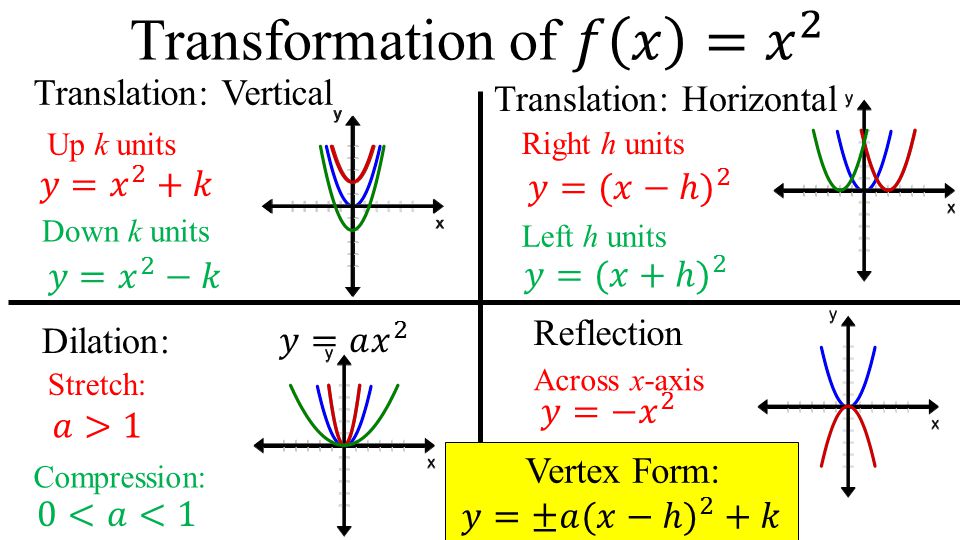http://prntscr.com/iuja4y
@563blackghost
You would split the equation down the middle. \(\bf{(x^{2}-4x)+(9x-36)}\) Next you need to factor out `x` and `9` from the equation. \(\bf{x(x-4)+9(x-4)}\) Now you have common terms. You would factor these out as well. \(\bf{x=4,-9}\)
For 4: Use this table to figure out the tranformation that is occuring.
Do you have an idea what the translation could be for 4?
Use the same table for question 5. |dw:1521671777913:dw|
A quadriatic function format is: \(\large\bf{y=x^{2}}\) There are 3 types of transformations: Translation, Reflection, and Dilation. ~ For translation there is a `vertical` or `horizontal` shift. If your equation moves `vertically up` it's format changes to \(\bf{y=x^{2}+k}\). If your equation moves `vertically down` it's format changes to \(\bf{y=x^{2}-k}\). `VERTICAL TRANSFORMATIONS ARE NOT CONTAINED IN PARENTHESIS!` If your equation moves `horizontal right` it's format changes to \(\bf{y=(x-h)^{2}}\). If your equation moves `horizontal left` it's format changes to \(\bf{y=(x+h)^{2}}\). `HORIZONTAL TRANSFORMATION ARE CONTAINED WITHIN PARENTHESIS!` ~~~ Dilation can be a compression or a stretch. They are represented as: \(\bf{y=ax^{2}}\) If the scaling is `larger than 1` then it is an `stretch`. If the scaling is `less than 1` then it is a `compression`. ~~~ Reflection would resort in a negative. ~~~
ah ok
In your equation you have: \(\large\bf{f(x)=4x^{2}+5}\) You see already that you have +5, this means that there is a `vertical translation of 5`. You also see that `4` is `multiplied` with \(\bf{x^{2}}\), this means that there is a stretch of the function. `BECAUSE 4 IS GREATER THAN 1`. Now your question asks for a `translation of 4 units up`. A translation that is vertical will not be contained in parenthesis, this means the format would be \(\bf{y=x^{2}+k}\) due to a shift upward of 4. So we apply.. \(\large\bf{f(x)=4x^{2}+5 \color{red}{+4}}\)
is now translated upwards
i guess..
dont mind my stupidity :/
yes the function is translating upward.
so i assume thats the g(x) equation
\(\bf{g(x)=4x^{2}+5+4}\) is g(x).
Join our real-time social learning platform and learn together with your friends!

